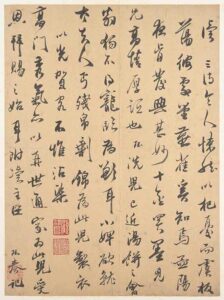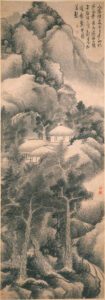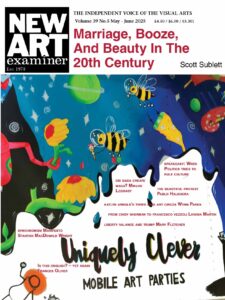
Song Jue: Letter (1576–1632)
John Haber

(1576–1632)
In the year 405, a Chinese magistrate made a bold move—not to seize still greater power, but to step down. He chose, as the Met puts it, to ‘remove [himself] from the flow,’ apart from the courtroom, the court, and their worldly concerns.
Not that a modest life meant a life without pleasures. He tended chrysanthemums, overflowing even his artistry, and he had plenty of time for drink. Nor did life as a recluse mean a life alone. He may or may not have raised a toast when he drank, but others did, and Lu Han made nature the setting for an entire pavilion for an ageing drunk in 1659. Among other famous recluses were the Seven Sages of the Bamboo Grove. They and the magistrate were just two foundational myths in Companions in Solitude.
You might attend any museum for companionship in solitude—and I do not mean the ugly crowds at blockbusters barring the way to Vincent van Gogh. You can always find privacy amid friends and strangers alike in the Met’s Astor Court, which recreates a Chinese scholar’s garden. Still, the very idea of a public space for contemplation underlies centuries of Asian art, give or take an occasional demon or a dragon. Contemporary Asian art has its urgency and its chaos, and global diversity has its terrors, as in African art, but this wing stands apart. And the Met has rehung much of it for what a subtitle calls ‘Reclusion and Communion in Chinese Art.’ It avoids crowding the art at that, with works in two instalments.
It could serve as a guide to an entire tradition. Chinese art has its evolution, often toward harder edges and a clearer sense of distance, although I am in way over my head to offer much of a guide. Still, artists kept looking back to earlier myths and earlier styles, for a deceptive unity. One can count on blank areas of paper, for gaps between near and far, as with Shitao in 1702, and sudden shifts in point of view from the sky to the ground. You may think of this painting as akin to calligraphy, but that hardly explains the fine detail of reeds and architecture for Liu Songnian in the 12th-century, or the brushy drama of mountains and clouds for Fu Baoshi in just the last hundred years. Mere shadows in the rocks may be the most calligraphic of all.
They are united, too, by being in touch with others through nothing more than subordination to nature. Finding the recluse can resemble a game of Where’s Waldo. Still, the human presences keep mounting the longer one looks, along with hints of human artistry and intervention. For starters, if one cannot renounce the city and community, one can always create a garden. One can, that is, with sufficient means and a fashion sense, and the Met speaks explicitly of the ‘elegant garden’. Wu Li shows a proper gentleman enjoying his garden, as Whiling Away the Summer from 1679.
Even in nature, subjects need not give up their occupations, no more than their pleasures. The museum speaks of the recluse as distinct from a traveller or a labourer. Yet recluses here can be fishermen at work or, with Zhang Lu, with family. They count as scholars because their very existence depends on nature. Sure enough, the Met describes a fishing village for Li Jie around 1170 as “one of the earliest depictions of a scholar’s country retreat”. Most of the show, though, dates from four centuries, starting with Wen Zhengming under the Ming dynasty, shortly before 1515. He, too, painted a summer retreat, and one can always count on an end to vacation.

Attributed to Gong Xian (1619–1689)
Human preoccupations appear, too, in images of women. They pose much like men, but often together, and more than one appears on a fan, a female accessory. More generally, human arts appear in the mix of painting and such crafts as ceramics and actual calligraphy. One need not distinguish art and design – not when ceramics bear some of the most vivid landscapes in white and blue. They can also be censers, for a religious ceremony, or a place to rest brushes for paint. Calligraphy can function as a colophon, the page identifying an artist’s book, or as poetry or letters for an artist to illustrate.
Not coincidentally, recluses in art may use the time to write poems or letters. They do so alone, but to share their discoveries and to stay in touch. Nature, in turn, can be the subject for contemplation or its enabler. In two of the most common motifs, a scholar marvels at a waterfall or finds shelter beneath a tree. Gentle or turbulent, nature’s motions will continue long after the painting is gone. But then, art’s stillness will persist long after the exhibition has ended, too.
Companions in Solitude – The Metropolitan Museum of Art July 31st 2021 – 14th August 2022

